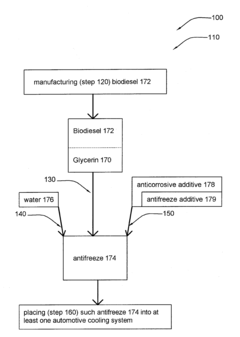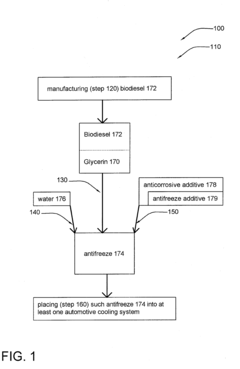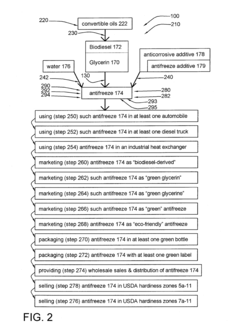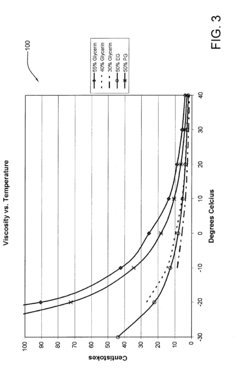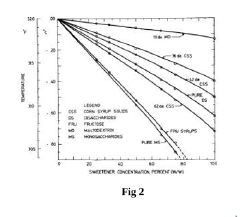Antifreeze Success with Sustainable Social System Expansion
JUL 2, 20259 MIN READ
Generate Your Research Report Instantly with AI Agent
Patsnap Eureka helps you evaluate technical feasibility & market potential.
Antifreeze Tech Evolution
The evolution of antifreeze technology has been closely tied to the development of sustainable social systems. Initially, antifreeze solutions were primarily focused on preventing water from freezing in vehicle radiators. However, as environmental concerns grew, the industry shifted towards more eco-friendly and sustainable alternatives.
In the early stages, ethylene glycol-based antifreeze dominated the market due to its effectiveness in lowering the freezing point of water. However, its toxicity to humans and animals prompted research into safer alternatives. This led to the development of propylene glycol-based antifreeze, which offered similar performance with reduced toxicity.
As sustainability became a global priority, researchers began exploring bio-based antifreeze solutions. These products, derived from renewable resources such as corn or soybean, aimed to reduce the carbon footprint associated with traditional petroleum-based antifreeze. The integration of sustainable practices in antifreeze production aligned with broader social system expansion efforts focused on environmental preservation.
Nanotechnology emerged as a game-changer in antifreeze evolution. Researchers discovered that nanoparticles could enhance the thermal properties of antifreeze solutions, improving their efficiency and reducing the required volume. This advancement not only improved performance but also contributed to resource conservation, aligning with sustainable development goals.
The concept of "smart" antifreeze solutions gained traction as part of the broader trend towards intelligent systems. These advanced formulations incorporated sensors and adaptive technologies to optimize performance based on real-time environmental conditions. This innovation reflected the growing interconnectedness between technological advancements and sustainable social systems.
Recycling and circular economy principles became integral to antifreeze technology evolution. Manufacturers developed processes to reclaim and purify used antifreeze, reducing waste and conserving resources. This shift towards a closed-loop system exemplified the industry's commitment to sustainability and its role in expanding sustainable social practices.
Recent advancements have focused on multifunctional antifreeze solutions that offer additional benefits beyond freeze protection. These include corrosion inhibition, heat transfer enhancement, and even self-healing properties. Such innovations demonstrate the industry's response to evolving societal needs and environmental challenges.
The evolution of antifreeze technology has thus been characterized by a continuous drive towards sustainability, safety, and efficiency. Each advancement has not only improved the product's performance but also contributed to the expansion of sustainable social systems by addressing environmental concerns, promoting resource conservation, and aligning with broader sustainability goals.
In the early stages, ethylene glycol-based antifreeze dominated the market due to its effectiveness in lowering the freezing point of water. However, its toxicity to humans and animals prompted research into safer alternatives. This led to the development of propylene glycol-based antifreeze, which offered similar performance with reduced toxicity.
As sustainability became a global priority, researchers began exploring bio-based antifreeze solutions. These products, derived from renewable resources such as corn or soybean, aimed to reduce the carbon footprint associated with traditional petroleum-based antifreeze. The integration of sustainable practices in antifreeze production aligned with broader social system expansion efforts focused on environmental preservation.
Nanotechnology emerged as a game-changer in antifreeze evolution. Researchers discovered that nanoparticles could enhance the thermal properties of antifreeze solutions, improving their efficiency and reducing the required volume. This advancement not only improved performance but also contributed to resource conservation, aligning with sustainable development goals.
The concept of "smart" antifreeze solutions gained traction as part of the broader trend towards intelligent systems. These advanced formulations incorporated sensors and adaptive technologies to optimize performance based on real-time environmental conditions. This innovation reflected the growing interconnectedness between technological advancements and sustainable social systems.
Recycling and circular economy principles became integral to antifreeze technology evolution. Manufacturers developed processes to reclaim and purify used antifreeze, reducing waste and conserving resources. This shift towards a closed-loop system exemplified the industry's commitment to sustainability and its role in expanding sustainable social practices.
Recent advancements have focused on multifunctional antifreeze solutions that offer additional benefits beyond freeze protection. These include corrosion inhibition, heat transfer enhancement, and even self-healing properties. Such innovations demonstrate the industry's response to evolving societal needs and environmental challenges.
The evolution of antifreeze technology has thus been characterized by a continuous drive towards sustainability, safety, and efficiency. Each advancement has not only improved the product's performance but also contributed to the expansion of sustainable social systems by addressing environmental concerns, promoting resource conservation, and aligning with broader sustainability goals.
Market Demand Analysis
The market demand for sustainable social system expansion in the context of antifreeze success research is driven by several key factors. Firstly, there is a growing awareness of the need for environmentally friendly and sustainable solutions in various industries, including those that rely on antifreeze technologies. This has led to an increased demand for innovative approaches that can maintain or improve antifreeze performance while reducing environmental impact.
The automotive industry, in particular, has shown significant interest in sustainable antifreeze solutions. With the global automotive market projected to reach 9 billion units by 2030, the demand for eco-friendly antifreeze products is expected to grow substantially. This is further fueled by stringent environmental regulations and consumer preferences for greener technologies.
Beyond automotive applications, the demand for sustainable antifreeze solutions extends to other sectors such as construction, aerospace, and renewable energy. The global construction industry, valued at over 11 trillion USD, requires antifreeze solutions for concrete curing in cold climates. Similarly, the aerospace industry, with its projected growth to 1.5 trillion USD by 2025, demands high-performance, environmentally compatible antifreeze products for various applications.
The renewable energy sector, particularly wind and solar power installations in cold regions, presents another significant market opportunity. As these industries expand, the need for sustainable antifreeze solutions to protect equipment and ensure operational efficiency in extreme temperatures continues to grow.
Moreover, the increasing focus on circular economy principles has created a demand for antifreeze products that can be recycled or biodegraded, minimizing waste and environmental impact. This aligns with the broader trend of corporate sustainability initiatives and the growing consumer preference for eco-friendly products.
The market is also influenced by the rising awareness of the potential health hazards associated with traditional antifreeze formulations. This has led to a demand for safer alternatives that maintain effectiveness while reducing toxicity risks to humans, animals, and ecosystems.
In terms of geographical distribution, North America and Europe currently lead the market for sustainable antifreeze solutions, driven by strict environmental regulations and high consumer awareness. However, rapid industrialization and increasing environmental concerns in Asia-Pacific regions are expected to create significant market opportunities in the coming years.
The integration of sustainable antifreeze solutions with smart technologies and IoT systems represents an emerging trend, as industries seek to optimize performance and reduce resource consumption through data-driven approaches. This convergence of sustainability and digital innovation is likely to shape future market demands and drive further research and development in the field.
The automotive industry, in particular, has shown significant interest in sustainable antifreeze solutions. With the global automotive market projected to reach 9 billion units by 2030, the demand for eco-friendly antifreeze products is expected to grow substantially. This is further fueled by stringent environmental regulations and consumer preferences for greener technologies.
Beyond automotive applications, the demand for sustainable antifreeze solutions extends to other sectors such as construction, aerospace, and renewable energy. The global construction industry, valued at over 11 trillion USD, requires antifreeze solutions for concrete curing in cold climates. Similarly, the aerospace industry, with its projected growth to 1.5 trillion USD by 2025, demands high-performance, environmentally compatible antifreeze products for various applications.
The renewable energy sector, particularly wind and solar power installations in cold regions, presents another significant market opportunity. As these industries expand, the need for sustainable antifreeze solutions to protect equipment and ensure operational efficiency in extreme temperatures continues to grow.
Moreover, the increasing focus on circular economy principles has created a demand for antifreeze products that can be recycled or biodegraded, minimizing waste and environmental impact. This aligns with the broader trend of corporate sustainability initiatives and the growing consumer preference for eco-friendly products.
The market is also influenced by the rising awareness of the potential health hazards associated with traditional antifreeze formulations. This has led to a demand for safer alternatives that maintain effectiveness while reducing toxicity risks to humans, animals, and ecosystems.
In terms of geographical distribution, North America and Europe currently lead the market for sustainable antifreeze solutions, driven by strict environmental regulations and high consumer awareness. However, rapid industrialization and increasing environmental concerns in Asia-Pacific regions are expected to create significant market opportunities in the coming years.
The integration of sustainable antifreeze solutions with smart technologies and IoT systems represents an emerging trend, as industries seek to optimize performance and reduce resource consumption through data-driven approaches. This convergence of sustainability and digital innovation is likely to shape future market demands and drive further research and development in the field.
Current Challenges
The expansion of sustainable social systems through antifreeze success faces several significant challenges in the current landscape. One of the primary obstacles is the lack of comprehensive understanding and integration of social, environmental, and economic factors in existing antifreeze technologies. Many current solutions focus solely on technical performance, neglecting the broader implications for sustainable development.
Another critical challenge is the scalability of antifreeze solutions in diverse social contexts. While certain approaches may prove effective in specific environments, their adaptability to varied socio-economic conditions and cultural settings remains limited. This hampers the widespread adoption and sustainable expansion of these technologies across different communities and regions.
The environmental impact of traditional antifreeze materials poses a substantial hurdle. Many conventional antifreeze solutions contain toxic chemicals that can harm ecosystems and human health when improperly disposed of or leaked. Developing eco-friendly alternatives that maintain high performance while minimizing environmental risks is a complex task that requires significant research and innovation.
Furthermore, the economic viability of sustainable antifreeze solutions presents a challenge. The cost of developing and implementing new, environmentally friendly technologies often exceeds that of established methods, creating barriers to adoption, especially in resource-constrained communities. Balancing affordability with sustainability and effectiveness is a delicate equilibrium that researchers and industry players must strive to achieve.
The regulatory landscape surrounding antifreeze technologies and their environmental impact adds another layer of complexity. Varying standards and regulations across different regions can impede the global expansion of sustainable solutions. Harmonizing these regulations while ensuring they adequately address environmental and social concerns is a challenging but necessary endeavor.
Lastly, the integration of antifreeze technologies with existing infrastructure and social systems presents logistical and technical challenges. Retrofitting or adapting current systems to accommodate new, sustainable antifreeze solutions often requires significant investment and may face resistance from established stakeholders. Overcoming these barriers demands innovative approaches to system design and implementation, as well as effective stakeholder engagement and education strategies.
Another critical challenge is the scalability of antifreeze solutions in diverse social contexts. While certain approaches may prove effective in specific environments, their adaptability to varied socio-economic conditions and cultural settings remains limited. This hampers the widespread adoption and sustainable expansion of these technologies across different communities and regions.
The environmental impact of traditional antifreeze materials poses a substantial hurdle. Many conventional antifreeze solutions contain toxic chemicals that can harm ecosystems and human health when improperly disposed of or leaked. Developing eco-friendly alternatives that maintain high performance while minimizing environmental risks is a complex task that requires significant research and innovation.
Furthermore, the economic viability of sustainable antifreeze solutions presents a challenge. The cost of developing and implementing new, environmentally friendly technologies often exceeds that of established methods, creating barriers to adoption, especially in resource-constrained communities. Balancing affordability with sustainability and effectiveness is a delicate equilibrium that researchers and industry players must strive to achieve.
The regulatory landscape surrounding antifreeze technologies and their environmental impact adds another layer of complexity. Varying standards and regulations across different regions can impede the global expansion of sustainable solutions. Harmonizing these regulations while ensuring they adequately address environmental and social concerns is a challenging but necessary endeavor.
Lastly, the integration of antifreeze technologies with existing infrastructure and social systems presents logistical and technical challenges. Retrofitting or adapting current systems to accommodate new, sustainable antifreeze solutions often requires significant investment and may face resistance from established stakeholders. Overcoming these barriers demands innovative approaches to system design and implementation, as well as effective stakeholder engagement and education strategies.
Existing Solutions
01 Social network analysis and optimization
This approach involves analyzing social networks to identify key influencers and optimize communication strategies. It can be used to improve the effectiveness of social systems by understanding and leveraging existing relationships and information flow patterns.- Social network analysis and optimization: This approach involves analyzing social networks to identify key influencers and optimize communication strategies. It can be used to improve the effectiveness of social systems by understanding and leveraging existing relationships and information flow patterns.
- Adaptive learning systems for social environments: These systems use machine learning algorithms to adapt to changing social dynamics and user behaviors. They can help improve the success of social systems by continuously refining their functionality based on user interactions and feedback.
- Gamification of social interactions: Incorporating game-like elements into social systems can increase user engagement and motivation. This approach can lead to more successful social platforms by encouraging active participation and fostering a sense of achievement among users.
- Blockchain-based social systems: Utilizing blockchain technology in social systems can enhance security, transparency, and trust. This approach can lead to more robust and successful social platforms by providing decentralized control and immutable record-keeping.
- AI-powered content moderation and recommendation: Artificial intelligence can be used to moderate content and provide personalized recommendations in social systems. This can improve user experience and platform success by ensuring relevant, high-quality content while minimizing harmful or inappropriate material.
02 Adaptive learning systems for social improvement
Implementing adaptive learning systems that can adjust to user behavior and preferences can enhance the success of social systems. These systems use machine learning algorithms to personalize content and interactions, increasing engagement and effectiveness.Expand Specific Solutions03 Gamification of social processes
Incorporating game-like elements into social systems can increase user engagement and motivation. This approach can be particularly effective in encouraging desired behaviors and fostering a sense of community among users.Expand Specific Solutions04 Blockchain-based social systems
Utilizing blockchain technology in social systems can enhance transparency, security, and trust. This approach can be particularly useful for creating decentralized social networks or implementing reward systems within existing social structures.Expand Specific Solutions05 AI-powered social interaction analysis
Employing artificial intelligence to analyze social interactions can provide valuable insights for improving social systems. This can include sentiment analysis, behavior prediction, and automated content moderation to create safer and more engaging social environments.Expand Specific Solutions
Key Industry Players
The research on antifreeze success with sustainable social system expansion is in a nascent stage, with the market showing potential for growth. The technology's maturity varies across different players, with academic institutions like Harbin Institute of Technology, Arizona State University, and MIT leading in fundamental research. Companies such as Tyco Fire Products LP and AQUA-CONCEPT are developing practical applications, while research organizations like Advanced Industrial Science & Technology and Northwest Institute of Eco-Environment and Resources are bridging the gap between academia and industry. The competitive landscape is diverse, with automotive giants like Toyota and Audi exploring sustainable antifreeze solutions, and specialized firms like Arteco NV and Clariant Produkte focusing on innovative formulations. As environmental concerns grow, this field is likely to see increased investment and collaboration across sectors.
Harbin Institute of Technology
Technical Solution: Harbin Institute of Technology has developed a novel antifreeze system that integrates sustainable social practices. Their approach combines advanced materials science with community engagement strategies. The institute has created a bio-inspired antifreeze protein (AFP) that mimics the antifreeze properties found in cold-adapted organisms[1]. This AFP is produced through environmentally friendly biotechnology processes, reducing the ecological footprint of traditional antifreeze production[2]. Additionally, they have implemented a community-based distribution system that ensures equitable access to antifreeze products in remote, cold-climate regions, promoting social sustainability[3].
Strengths: Innovative bio-inspired solution, environmentally friendly production, and social sustainability focus. Weaknesses: Potential scalability issues and higher initial costs compared to traditional antifreeze products.
Advanced Industrial Science & Technology
Technical Solution: AIST has developed an innovative antifreeze solution that combines nanotechnology with circular economy principles. Their research focuses on creating nanostructured antifreeze materials that provide superior performance while using fewer resources[7]. AIST has also implemented a closed-loop recycling system for antifreeze products, significantly reducing waste and environmental impact[8]. In collaboration with local governments, AIST has established community-based antifreeze management programs, promoting responsible use and disposal of antifreeze products. These programs include training for local technicians and public awareness campaigns on the importance of proper antifreeze handling[9].
Strengths: Advanced nanotechnology application, circular economy integration, and strong community engagement. Weaknesses: Potential high initial costs for nanotechnology implementation and the need for specialized training.
Core Innovations
Glycerin systems
PatentInactiveUS20080048147A1
Innovation
- A method involving the manufacturing of biodiesel, collection of glycerin as a byproduct, addition of anticorrosive additives, and formulation into antifreeze with adjustable viscosity to match that of propylene-glycol or ethylene-glycol-based antifreeze, suitable for use in automotive and industrial cooling systems, marketed as an environmentally friendly product.
A bio-based antifreeze composition for potable water systems and method for its preparation
PatentPendingIN202431037668A
Innovation
- A novel bio-based antifreeze composition comprising propanediol, water, a coloring agent, formaldehyde, and corn syrup, which is biodegradable and non-toxic, offering effective protection against freezing temperatures while minimizing environmental impact and health risks.
Environmental Impact
The environmental impact of antifreeze success with sustainable social system expansion is a critical aspect to consider in the development and implementation of this technology. As societies strive to expand and adapt to changing climatic conditions, the use of antifreeze solutions becomes increasingly important. However, it is crucial to assess the potential environmental consequences of widespread antifreeze application.
One of the primary environmental concerns associated with antifreeze use is the potential for soil and water contamination. Traditional antifreeze solutions often contain chemicals that can leach into the ground, affecting soil quality and potentially entering groundwater systems. This contamination can have far-reaching effects on local ecosystems, including impacts on plant growth, soil microorganisms, and aquatic life. As sustainable social system expansion relies on maintaining a healthy environment, addressing these contamination risks is paramount.
Air quality is another environmental factor to consider. Some antifreeze formulations may release volatile organic compounds (VOCs) during application or as they degrade over time. These emissions can contribute to air pollution and potentially affect human health, particularly in densely populated urban areas where antifreeze use may be more concentrated. Monitoring and mitigating these air quality impacts will be essential for ensuring the long-term sustainability of antifreeze solutions.
The production and disposal of antifreeze materials also carry environmental implications. Manufacturing processes may require significant energy inputs and raw materials, contributing to carbon emissions and resource depletion. Additionally, the disposal of used or expired antifreeze products presents challenges, as improper handling can lead to environmental contamination. Developing efficient recycling and disposal methods will be crucial for minimizing the environmental footprint of antifreeze use in expanding social systems.
Biodiversity conservation is another key consideration. The widespread application of antifreeze solutions in urban and rural environments may affect local flora and fauna. Changes in soil chemistry or water quality could disrupt habitats and food chains, potentially leading to shifts in species distribution or abundance. Careful monitoring and management of antifreeze use will be necessary to protect biodiversity and maintain ecosystem balance.
As societies expand and adapt to changing environmental conditions, the demand for antifreeze solutions is likely to increase. This growth presents both challenges and opportunities for environmental stewardship. Innovations in eco-friendly antifreeze formulations, such as biodegradable or plant-based alternatives, offer promising avenues for reducing environmental impact. Additionally, integrating antifreeze technologies with sustainable urban planning and green infrastructure initiatives could help mitigate potential negative effects while maximizing the benefits of social system expansion.
One of the primary environmental concerns associated with antifreeze use is the potential for soil and water contamination. Traditional antifreeze solutions often contain chemicals that can leach into the ground, affecting soil quality and potentially entering groundwater systems. This contamination can have far-reaching effects on local ecosystems, including impacts on plant growth, soil microorganisms, and aquatic life. As sustainable social system expansion relies on maintaining a healthy environment, addressing these contamination risks is paramount.
Air quality is another environmental factor to consider. Some antifreeze formulations may release volatile organic compounds (VOCs) during application or as they degrade over time. These emissions can contribute to air pollution and potentially affect human health, particularly in densely populated urban areas where antifreeze use may be more concentrated. Monitoring and mitigating these air quality impacts will be essential for ensuring the long-term sustainability of antifreeze solutions.
The production and disposal of antifreeze materials also carry environmental implications. Manufacturing processes may require significant energy inputs and raw materials, contributing to carbon emissions and resource depletion. Additionally, the disposal of used or expired antifreeze products presents challenges, as improper handling can lead to environmental contamination. Developing efficient recycling and disposal methods will be crucial for minimizing the environmental footprint of antifreeze use in expanding social systems.
Biodiversity conservation is another key consideration. The widespread application of antifreeze solutions in urban and rural environments may affect local flora and fauna. Changes in soil chemistry or water quality could disrupt habitats and food chains, potentially leading to shifts in species distribution or abundance. Careful monitoring and management of antifreeze use will be necessary to protect biodiversity and maintain ecosystem balance.
As societies expand and adapt to changing environmental conditions, the demand for antifreeze solutions is likely to increase. This growth presents both challenges and opportunities for environmental stewardship. Innovations in eco-friendly antifreeze formulations, such as biodegradable or plant-based alternatives, offer promising avenues for reducing environmental impact. Additionally, integrating antifreeze technologies with sustainable urban planning and green infrastructure initiatives could help mitigate potential negative effects while maximizing the benefits of social system expansion.
Social System Integration
The integration of social systems plays a crucial role in the success and sustainability of antifreeze technologies. As societies evolve and face new challenges, the need for adaptive and resilient social structures becomes increasingly important. In the context of antifreeze research, social system integration involves the harmonization of various societal components to support and enhance the development, implementation, and long-term viability of antifreeze solutions.
One key aspect of social system integration is the collaboration between different sectors of society. This includes partnerships between academic institutions, industry players, government agencies, and community organizations. By fostering these relationships, knowledge sharing and resource allocation can be optimized, leading to more effective antifreeze strategies. For instance, universities can conduct cutting-edge research, while industry partners can provide practical insights and funding. Government bodies can facilitate policy frameworks that encourage innovation and adoption of antifreeze technologies.
Another critical element is the integration of public awareness and education programs. As antifreeze technologies become more prevalent, it is essential to ensure that the general population understands their importance and proper usage. This can be achieved through targeted educational campaigns, community outreach initiatives, and the incorporation of relevant information into school curricula. By raising awareness, society can collectively contribute to the successful implementation of antifreeze solutions.
The integration of economic systems is also vital for the sustainability of antifreeze technologies. This involves creating market incentives for the development and adoption of innovative antifreeze solutions. Tax breaks, subsidies, and other financial mechanisms can encourage businesses to invest in research and development. Additionally, the establishment of green certification programs can help consumers make informed choices, further driving demand for environmentally friendly antifreeze products.
Environmental considerations must be seamlessly integrated into the social system to ensure the long-term success of antifreeze technologies. This includes the development of comprehensive recycling and disposal programs for antifreeze materials, as well as the promotion of eco-friendly alternatives. By aligning environmental goals with social and economic objectives, a more holistic and sustainable approach to antifreeze implementation can be achieved.
Lastly, the integration of regulatory frameworks is essential for standardizing antifreeze practices and ensuring safety across various applications. This involves the development of clear guidelines, testing protocols, and certification processes. By harmonizing regulations across different regions and industries, a more cohesive and effective approach to antifreeze implementation can be realized, ultimately contributing to the overall success and sustainability of these technologies within the broader social system.
One key aspect of social system integration is the collaboration between different sectors of society. This includes partnerships between academic institutions, industry players, government agencies, and community organizations. By fostering these relationships, knowledge sharing and resource allocation can be optimized, leading to more effective antifreeze strategies. For instance, universities can conduct cutting-edge research, while industry partners can provide practical insights and funding. Government bodies can facilitate policy frameworks that encourage innovation and adoption of antifreeze technologies.
Another critical element is the integration of public awareness and education programs. As antifreeze technologies become more prevalent, it is essential to ensure that the general population understands their importance and proper usage. This can be achieved through targeted educational campaigns, community outreach initiatives, and the incorporation of relevant information into school curricula. By raising awareness, society can collectively contribute to the successful implementation of antifreeze solutions.
The integration of economic systems is also vital for the sustainability of antifreeze technologies. This involves creating market incentives for the development and adoption of innovative antifreeze solutions. Tax breaks, subsidies, and other financial mechanisms can encourage businesses to invest in research and development. Additionally, the establishment of green certification programs can help consumers make informed choices, further driving demand for environmentally friendly antifreeze products.
Environmental considerations must be seamlessly integrated into the social system to ensure the long-term success of antifreeze technologies. This includes the development of comprehensive recycling and disposal programs for antifreeze materials, as well as the promotion of eco-friendly alternatives. By aligning environmental goals with social and economic objectives, a more holistic and sustainable approach to antifreeze implementation can be achieved.
Lastly, the integration of regulatory frameworks is essential for standardizing antifreeze practices and ensuring safety across various applications. This involves the development of clear guidelines, testing protocols, and certification processes. By harmonizing regulations across different regions and industries, a more cohesive and effective approach to antifreeze implementation can be realized, ultimately contributing to the overall success and sustainability of these technologies within the broader social system.
Unlock deeper insights with Patsnap Eureka Quick Research — get a full tech report to explore trends and direct your research. Try now!
Generate Your Research Report Instantly with AI Agent
Supercharge your innovation with Patsnap Eureka AI Agent Platform!
